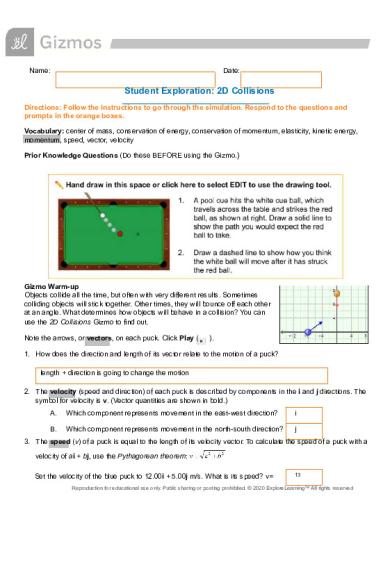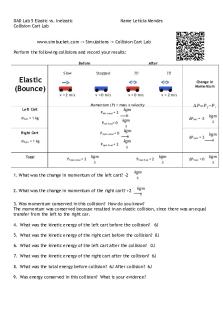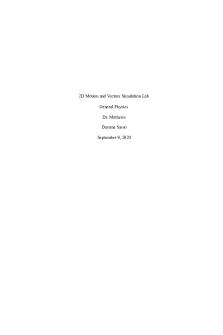Physics 2 14 & 2 15 - Accident Reconstruction Task #3 2D Collision Simulation PDF

| Title | Physics 2 14 & 2 15 - Accident Reconstruction Task #3 2D Collision Simulation |
|---|---|
| Author | Louis Kouemeni |
| Course | Honors Physics |
| Institution | Middleton High School |
| Pages | 5 |
| File Size | 265.6 KB |
| File Type | |
| Total Downloads | 71 |
| Total Views | 139 |
Summary
Gizmos for Honors physics in the Accident reconstruction lab conducted to determine a crash accident with physics. 9-12th grade physics....
Description
Name:
Date:
Student Exploration: 2D Collisions Directions: Follow the instructions to go through the simulation. Respond to the questions and prompts in the orange boxes. Vocabulary: center of mass, conservation of energy, conservation of momentum, elasticity, kinetic energy, momentum, speed, vector, velocity Prior Knowledge Questions (Do these BEFORE using the Gizmo.)
Gizmo Warm-up Objects collide all the time, but often with very different results. Sometimes colliding objects will stick together. Other times, they will bounce off each other at an angle. What determines how objects will behave in a collision? You can use the 2D Collisions Gizmo to find out. Note the arrows, or vectors, on each puck. Click Play (
).
1. How does the direction and length of its vector relate to the motion of a puck? length + direction is going to change the motion 2. The velocity (speed and direction) of each puck is described by components in the i and j directions. The symbol for velocity is v. (Vector quantities are shown in bold.) A.
Which component represents movement in the east-west direction?
i
B.
Which component represents movement in the north-south direction?
j
3. The speed (v) of a puck is equal to the length of its velocity vector. To calculate the speed of a puck with a velocity of ai + bj, use the Pythagorean theorem: Set the velocity of the blue puck to 12.00i + 5.00j m/s. What is its speed? v=
13
Reproduction for educational use only. Public sharing or posting prohibited. © 2020 ExploreLearning™ All rights reserved
Get the Gizmo ready: Activity A:
● Click Reset. Make sure Elasticity is set to 1.0. ● Set the blue puck’s velocity to v = 4.00i + 3.00j and the gold puck’s velocity to v = 0.00i – 4.00j.
Elastic collisions
Introduction: An object’s elasticity describes how readily it returns to its original shape after it has collided with another object. In a perfectly elastic collision (in which elasticity equals 1), the two colliding objects return to their original shape immediately after the collision takes place. Question: What is conserved during an elastic collision? 1. Calculate: The kinetic energy (KE) of an object is a measure of its energy of motion. The equation for kinetic energy is: KE = mv2 ÷ 2, and the unit for kinetic energy is the joule (J). In the equation, m represents an object’s mass and v represents its velocity. A. Calculate the kinetic energy of each puck. (Note: The mass of the pucks can be found on the CONTROLS pane, and the magnitude of the pucks’ velocities ( v) can be found at the bottom of the SIMULATION pane.) Blue puck KE =
62.5
Gold puck KE =
24
B. Add the kinetic energy of the blue puck to that of the gold puck to find the total kinetic energy for the system. Total system KE =
86.5
2. Compare: Turn on Velocity vectors during motion. Click Play and observe the pucks. A. Calculate the final kinetic energy of the two pucks and the total system. Blue puck KE =
11.4
Gold puck KE =
75
Total system KE =
86.5
Use the CALCULATION tab to check your work. B. How did the kinetic energies of the two pucks change, and how can you explain these changes? blue went from 62.5 to 11.4, gold 24 to 75 C. How did the total system kinetic energy before the collision compare to that of after the collision?
system energy stays the same
3. Make a rule: Complete the sentence: During an elastic collision, the total kinetic energy of the system
stayed the same
. This rule is part of the law of conservation of energy.
Reproduction for educational use only. Public sharing or posting prohibited. © 2020 ExploreLearning™ All rights reserved
4. Calculate: It takes force to deflect or stop a moving object. Momentum (p) is a measure of an object’s tendency to continue moving in a given direction. The formula for momentum is p = mv and the unit is newton-seconds (kg•m/s). Click Reset. Select the CONTROLS tab. Because momentum has direction, it can be described in both the i direction and j direction. Calculate the initial momentums (pay attention to +/- signs): Blue puck:
p in i direction =
20
p in j direction =
15
Gold puck:
p in i direction =
0
p in j direction =
-12
Total system:
p in i direction =
20
p in j direction =
3
5. Calculate: Click Play and observe the pucks collide. Calculate the final momentums: Blue puck:
p in i direction =
0.05 * 5
p in j direction =
2.14 * 5
Gold puck:
p in i direction =
6.59 * 3
p in j direction =
-2.57 * 3
Total system:
p in i direction =
20
p in j direction =
3
Use the CALCULATION tab to check your answers. 6. Compare: Look at the momentum values you calculated for before and after the collision. A. What did you notice about the total system momentum in the i direction? Same B. What did you notice about the total system momentum in the j direction? same During an elastic collision, the total momentum in both the i direction and the j direction remains the same. This rule is part of the law of conservation of momentum. 7. Compare: Click Reset. Select the MOMENTUM tab. Set up several different collisions. Click Play. Then, compare the gray Total momentum vector Before and After the collision. A.
How do the Before and After vectors compare?
Same
B.
What does this observation confirm?
conservation of momentum
Reproduction for educational use only. Public sharing or posting prohibited. © 2020 ExploreLearning™ All rights reserved
Activity B:
Get the Gizmo ready: ● Click Reset. ● On the CONTROLS tab, turn on Puck trails.
Inelastic collisions
Question: What is conserved during an inelastic collision? 1. Observe: Use the Gizmo to set up a new collision. Run the simulation first with an Elasticity of 1.0. Then, run the simulation with an Elasticity of 0.0. What was the effect of decreasing the elasticity? The balls lost less energy and more energy was given to the gold puck 2. Predict: In activity A, you found that both total kinetic energy and total momentum are conserved in a perfectly elastic collision. How do you think decreasing the elasticity of a collision will affect the total momentum and total kinetic energy after the collision?
3. Experiment: Move the blue puck to point (-4.0, -6.0). Set its Initial velocity to v = 3.00i + 6.00j. Set the Initial velocity of the gold puck to v = 0.00i – 6.00j. Use the Gizmo’s Elasticity slider and CALCULATION tab to complete the table. Blue puck Elasticity
Stage
p (kg•m/s)
TKE (J)
Gold puck p (kg•m/s)
TKE (J)
Total p (kg•m/s)
Total TKE (J)
Before
62.50
24
86.50
After
11.48
75.02
86.50
Before
62.50
24.00
86.50
After
16.57
49.48
66.05
Before
62.50
24.00
86.50
After
26.76
32.47
59.23
1.0
0.5
0.0
Reproduction for educational use only. Public sharing or posting prohibited. © 2020 ExploreLearning™ All rights reserved
4. Analyze: Study the data you collected in the table on the previous page. A. In an inelastic collision, how did the total momentum (p) of the system change? The system momentum stayed in same B. In an inelastic collision, how did the total kinetic energy of the system change? The system kinetic energy C. How were the inelastic collisions different from the elastic collision? Elastic preserves energy, while inelastic transfer it into other mediums 5. Make a rule: Complete the sentence: During an inelastic collision, the total momentum of the system is
the same
, while kinetic energy is
lost
6. Infer: Why do you think some of the kinetic energy is lost during an inelastic collision? The objects hit together and compress and cannot spring back.
7. Think about it: Suppose a meteorite collided head-on with Mars and became buried under Mars’s surface. What would be the elasticity of this collision? Explain your answer. The elasticity would still be their, but not enough to overcome the force of weight.
Reproduction for educational use only. Public sharing or posting prohibited. © 2020 ExploreLearning™ All rights reserved...
Similar Free PDFs

Workshop 14 Task 2
- 3 Pages

Plaxis 2D Simulation Report
- 13 Pages

Collision Lab Report 2
- 9 Pages

Practica 2 Mathematica 14 15
- 18 Pages

PHYSICS 2 LAB 3
- 3 Pages

Task 2 - Task 2
- 5 Pages

2-2 simulation discussion
- 1 Pages

QHT1 Task 2 - Task 2
- 1 Pages

Task 2 - C226 Task 2
- 7 Pages

D082 Task 2 - Task 2
- 3 Pages

TDT1 Task 2 - Task 2
- 4 Pages
Popular Institutions
- Tinajero National High School - Annex
- Politeknik Caltex Riau
- Yokohama City University
- SGT University
- University of Al-Qadisiyah
- Divine Word College of Vigan
- Techniek College Rotterdam
- Universidade de Santiago
- Universiti Teknologi MARA Cawangan Johor Kampus Pasir Gudang
- Poltekkes Kemenkes Yogyakarta
- Baguio City National High School
- Colegio san marcos
- preparatoria uno
- Centro de Bachillerato Tecnológico Industrial y de Servicios No. 107
- Dalian Maritime University
- Quang Trung Secondary School
- Colegio Tecnológico en Informática
- Corporación Regional de Educación Superior
- Grupo CEDVA
- Dar Al Uloom University
- Centro de Estudios Preuniversitarios de la Universidad Nacional de Ingeniería
- 上智大学
- Aakash International School, Nuna Majara
- San Felipe Neri Catholic School
- Kang Chiao International School - New Taipei City
- Misamis Occidental National High School
- Institución Educativa Escuela Normal Juan Ladrilleros
- Kolehiyo ng Pantukan
- Batanes State College
- Instituto Continental
- Sekolah Menengah Kejuruan Kesehatan Kaltara (Tarakan)
- Colegio de La Inmaculada Concepcion - Cebu




